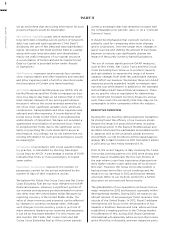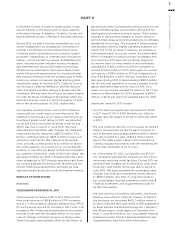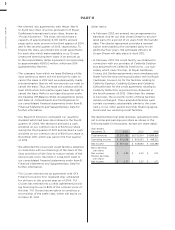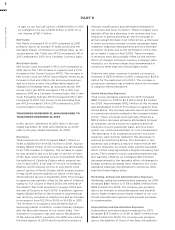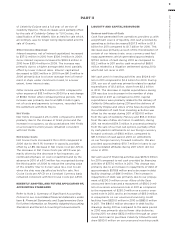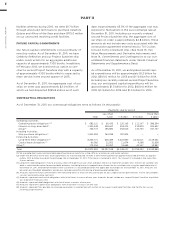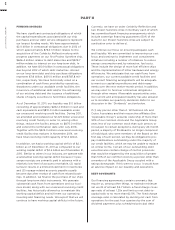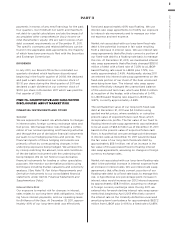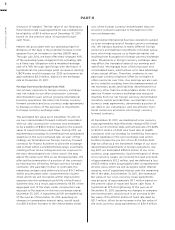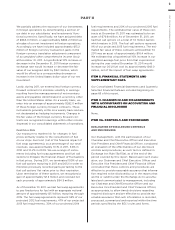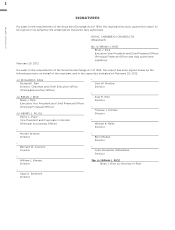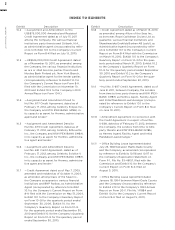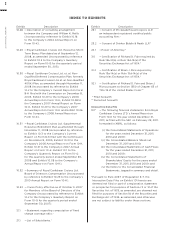Royal Caribbean Cruise Lines 2011 Annual Report Download - page 58
Download and view the complete annual report
Please find page 58 of the 2011 Royal Caribbean Cruise Lines annual report below. You can navigate through the pages in the report by either clicking on the pages listed below, or by using the keyword search tool below to find specific information within the annual report.
2011 ANNUAL REPORT 54
PART II
FUNDING SOURCES
We have significant contractual obligations of which
the capital expenditures associated with our ship
purchases and our debt service obligations represent
our largest funding needs. We have approximately
$2.0 billion in contractual obligations due in 2012 of
which approximately $764.1 million relates to the
acquisition of the Celebrity Reflection along with
progress payments on our first Project Sunshine ship,
$626.4 million relates to debt maturities and $329.7
million relates to interest on our long-term debt. In
addition, we have $10.9 billion in contractual obligations
due beyond 2012 of which debt maturities, interest
on our long-term debt and ship purchase obligations
represent $7.8 billion, $991.0 million and $787.8 mil-
lion, respectively. We have historically relied on a
combination of cash flows provided by operations,
drawdowns under our available credit facilities, the
incurrence of additional debt and/or the refinancing
of our existing debt and the issuance of additional
shares of equity securities to fund these obligations.
As of December 31, 2011, our liquidity was $1.1 billion
consisting of approximately $262.2 million in cash and
cash equivalents and $810.0 million available under
our unsecured revolving credit facilities. During 2011,
we amended and restated our $1.225 billion unsecured
revolving credit facility in order to, among other
things, reduce the facility amount to $875.0 million
and extend the termination date until July 2016.
Together with the $525.0 million unsecured revolving
credit facility that matures in November 2014, we
have total revolving credit capacity of $1.4 billion.
In addition, we had a working capital deficit of $2.1
billion as of December 31, 2011 as compared to our
working capital deficit of $2.4 billion as of December 31,
2010. Similar to others in our industry, we operate with
a substantial working capital deficit because (1) pas-
senger receipts are primarily paid in advance with a
relatively low-level of accounts receivable, (2) rapid
turnover results in a limited investment in inventories
and (3) voyage-related accounts payable usually
become due after receipt of cash from related book-
ings. In addition, we finance the purchase of our ships
through long-term debt instruments. We generate
substantial cash flows from operations and our busi-
ness model, along with our unsecured revolving credit
facilities, has historically allowed us to maintain this
working capital deficit and still meet our operating,
investing and financing needs. We expect that we will
continue to have working capital deficits in the future.
Currently, we have on order Celebrity Reflection and
two Project Sunshine ships in Germany each of which
has committed bank financing arrangements which
include sovereign financing guarantees (50% of the
loans for our Project Sunshine ships are subject to
syndication prior to delivery).
We continue our focus on ensuring adequate cash
and liquidity. We are committed to improving our cost
focus and continue to implement cost containment
initiatives including a number of initiatives to reduce
energy consumption and, by extension, fuel costs.
These include the design of more fuel efficient ships
and the implementation of other hardware and energy
efficiencies. We anticipate that our cash flows from
operations, our current available credit facilities and
our current financing arrangements will be adequate
to meet our capital expenditures and debt repay-
ments over the next twelve-month period. In addition,
we may elect to fund our contractual obligations
through other means if favorable opportunities arise.
Our current and anticipated liquidity has also allowed
us to reinstate our quarterly dividends. Refer to our
discussion in the “Dividends” section below.
If (i) any person other than A. Wilhelmsen AS. and
Cruise Associates and their respective affiliates (the
“Applicable Group”) acquires ownership of more than
30% of our common stock and the Applicable Group
owns less of our common stock than such person, or
(ii) subject to certain exceptions, during any 24-month
period, a majority of the Board is no longer comprised
of individuals who were members of the Board on the
first day of such period, we may be obligated to pre-
pay indebtedness outstanding under the majority of
our credit facilities, which we may be unable to replace
on similar terms. Certain of our outstanding debt
securities also contain change of control provisions
that would be triggered by the acquisition of greater
than 50% of our common stock by a person other than
a member of the Applicable Group coupled with a
ratings downgrade. If this were to occur, it would have
an adverse impact on our liquidity and operations.
DEBT COVENANTS
Our financing agreements contain covenants that
require us, among other things, to maintain minimum
net worth of at least $5.7 billion, a fixed charge cover-
age ratio of at least 1.25x and limit our net debt-to-
capital ratio to no more than 62.5%. The fixed charge
coverage ratio is calculated by dividing net cash from
operations for the past four quarters by the sum of
dividend payments plus scheduled principal debt


